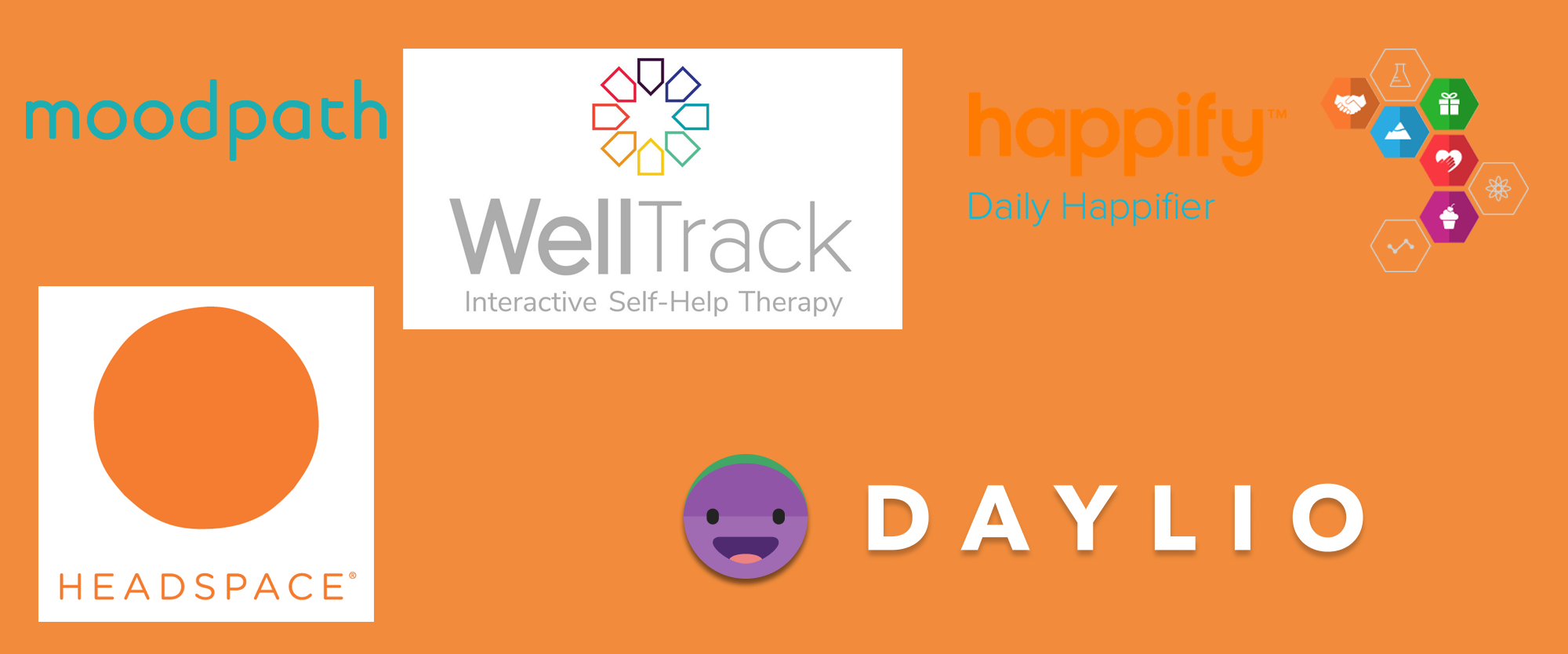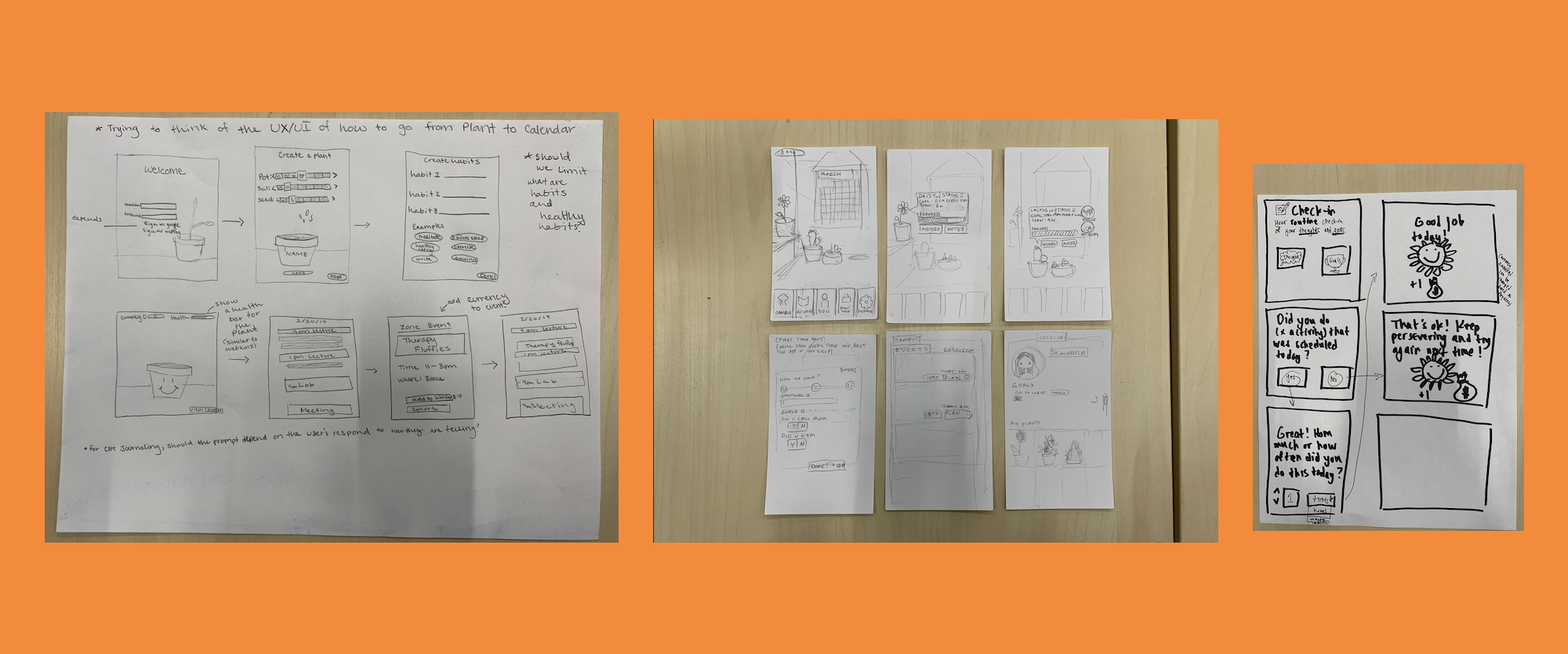
DFA Mental Wellness
One of my favorite parts of my design journey definitely has to be my time with Design for America at school, especially because of all the friends I was able to be on board with in my last year. This org started out as a small org and gateway to my first experience with HCD, and it continued to grow as an org and into a group of friends and community that I still think about today! :-)
I was especially excited about this project because mental health is very important to me, so being able to employ HCD to work toward a solution kept me invested. My team's solution to the problem space of mental wellness for college students was a mobile application, with collaboration from Triton Software Engineering and International Health Collective.
Roles: I led and had a heavy in hand in organizing and conducting interviews with mental health professionals during the winter quarter of the year
Skills: Needfinding, organizing data into themes, personas, journey maps, competitive analysis, scoping, ideating, participatory design workshop facilitation
Date: Sep 18 - Jun 19
Teammates: Nancy Zheng, Andres Baez, April Gau, Amaya Mali, Hunter Lai, Devadatta Baruah, Caitlyn Gonzales, Darin Lee, Lucy Cummings, Brittany Chen
Overview
The result of our collaboration was our application, tentatively named Sprout as of this entry, that allows students from UC San Diego to input their schedules to find events and activities related to mental wellness based on their availability. Users are incentivized by the growth of a plant avatar whose growth depends on the completion of activities or attendance on behalf of the user.
Our solution is consistent with issues that were persistent with the lack of use of on-campus resources such as inconvenient sourcing (students struggle to find a space where they can view all events as once), difficult timing (students struggle to find events or activities that fit their schedule), as well as general lack of information (students know about CAPS on-campus but not much else). Sprout’s scheduling functionality will match all existing events with open spaces in the user’s schedule which addresses both inconvenient sourcing as well as difficulty of timing. An additional functionality within the application will simply act as an information page which provides students with additional knowledge on topics like CBT or Cognitive Behavioral Therapy in addition to off-campus resources that might be helpful to them. All of these features were validated through findings from research.
Identifying and immersion of the problem
At the beginning of the year we identified mental wellness as a relevant and scalable issue. Universities report increased mental health crises by students during the academic year and that the scale and depth of this issue was similar at other academic institutions.
After identifying this issue, we wanted to spend the quarter in the immersion phase, which focused on:
- research
- building emapthy
- organizing recurring themes
For this phase, we spent the rest of the quarter leveraging online research. As a team we looked at and discussed:
- research articles
- reports from relevant NGOs
- social media pages relevant to mental wellness (e.g. Confessions pages)
By looking at these resources, we were able to get a better understanding on what use cases were for mental health issues in academic environments.
After this secondary research, we did activities as a group that focused on building more empathy via:
- personas
- journey maps
- mind maps
Ideation and design
During the winter quarter, our team's goals were to get through the ideation and design phase of our project, which could be broken into:
- competitive analysis of other mental wellness-related applications
- creating How-Can-We statements
- ideating functionalities
- proposing functionalities to TSE
Examples of existing mental health applications we took inspiration from were cognitive behavioral therapy, meditation, and mood tracking apps such as WellTrack, Headspace, and Daylio repsectively.
We then made HCW statements that asked: how can we gameify and instill good habits that increase mental health?
After this ideation and during the prototyping phase, we split into two subteams that focused on the Plant avatar and Scheduling features, respectively. In the Scheduling team, I contributed ideas and we proposed synchronization of personal schedules with on-campus resources plus daily check-ins/journaling. The Plant team specified features involving gamification of habit tracking through the plant avatars and currency/rewards.
My team and I each made paper prototypes with the focus of getting our own ideas conceptualized and consolidated them in later meetings, with the functionalities being proposed to Triton Software Engineering.



Pivot and reframing HCW statements
During the spring quarter, we wanted to do more intensive research and validate the assumptions we made about the problem space from early on in the immersion phase. To achieve this, we made goals to:
- conduct user research with student interviews and surveys targeted at UC San Diego students
- conduct research with professionals in the field of helping college students and any peripheral mental health persons
- hold a participatory design workshop with students and professionals
- gather and organize data from these findings and look into redesigning our product
Why and how did we decide on going back into research? We reflected upon the wording of our HCW statements at the time, and realized that by focusing on gameifying and instilling good habits, we narrowed the types of solutions we would seek out and iterate upon from the start.
I found this personally illuminating when we realized that we needed to word our HCW statements to be more insight centric, rather than solution centric. By framing our statements within a structure of user-place-behavior and using that to inform our measures of success, we came up with:
- How can we students feel more comfortable talking about mental health on-campus?
- How can we help students take more advantage of on campus resources?
- How can we help students be more aware of their mental health?
Further user research
The previous subteams were dissolved for a new set of subteams focused on Students, Professionals, and Workshop planning respectively. The student subteam compiled a survey with questions suited for students and distributed it amongst fellow classmates as well as on major social media pages to collect answers from the student population of UC San Diego. The student subteam also created an interview guide and conducted 6 interviews in person with at least two members of the team present.
As part of the professional subteam, I helped create the interview guide and made a table of potential interviewees to keep track of correspondence. In total, I interviewed 6 people total, 2 from the Pyschology/Psi Chi club, 3 psychologists from the VA hospital, and 1 CAPS counselor. The questions focused on trying to understand their day-to-day experience in working with students or mental health patients and learning of potential resources or opportunities.
Through interviewing health professionals at the local VA hospital and UC San Diego's CAPS, some notable things I learned were:
- about online resources that provide a framework for telemental health solutions, e.g. PTSD coach and CBT worksheets
- other telemental health applications involving CBT and how they work and benefit users
- UC San Diego students feel a specific sense of isolation through their performance in STEM courses versus their peers
- UCSD students seldom use free mental wellness resources (e.g. group therapy sessions) that aren't as publicized as their CAPS drop-in sessions/call system
Participatory design workshop
See the agenda for the workshop here!Simultaneously, our team invited our stakeholders to validate our application features and give us insights on their journeys surrounding mental wellness. Around 10 stakeholders ended up showing up, including 2 IHC UCSD alumni, a member from TSE, our advisor from IHC as the mental health professional stakeholder, and UCSD students of various backgrounds.
After the completion of the workshop, the team re-evaluated the data collected from the interviews and reviewed the data from the workshop. The data collected from the workshop validated previous designs that were created in the Winter Quarter. Based on this data, we decided to move forward with the designs and instead applied small modifications to better represent insights from the workshop.
Some significant findings were that:
- out of the resource centers available, students are commonly aware of resources on campus like CAPS, The Zone, SARC
- many students used Headspace if any mental health apps were used
- students are not aware of less publicized mental health resources that aren't CAPS sessions
- some like to avoid CAPS and try to handle stress on their own due to distrust of therapy efficacy
After getting attached to all the work, I'm still excited to see how the new team tackles the problem given our documentation during the 19-20 school year!
